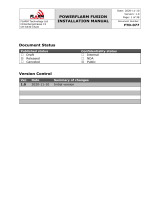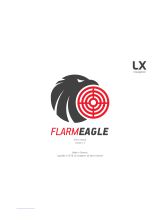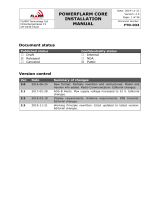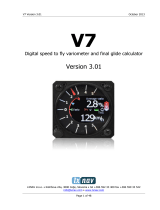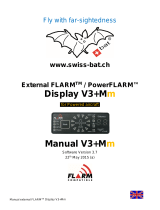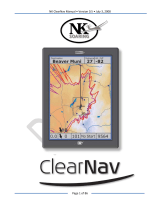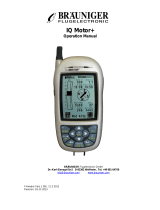Page is loading ...

USER MANUAL
FlarmLED+
Version 1.39
December 2021
www.lxnav.com

Rev #14
Version 1.39 December 2021
Page 2 of 32
1
Important Notices 3
1.1 Limited Warranty 3
1.1.1 Disposal of Old Electrical & Electronic Equipment 4
1.2 Flarm end user license agreement 4
2
General overview 8
3
Packing Lists 9
4
Installation 10
5
LXNAV FlarmLED+ Basics 11
5.1 LXNAV FlarmLED+ display at a Glance 11
5.1.1 LXNAV FlarmLED+ display features 11
5.1.2 Interfaces 11
5.1.3 Technical Data 11
6
System Description 12
6.1 Description of FlarmLED+ 12
6.1.1 Status LEDs 12
6.1.2 Horizontal direction LEDs 12
6.1.3 Vertical direction LEDs 13
6.1.4 Distance to the target indicator 13
6.1.5 Touch pads 13
6.1.6 ALS 14
6.2 Powering up FlarmLED+ 14
6.3 Normal operation 14
6.3.1 WARNING Modes: 14
6.3.2 NEAREST Mode: 14
6.3.2.1 Multi target in nearest modus 15
6.3.3 Obstacle warning 16
6.3.4 Alert zone warning 16
6.3.5 Undirected PCAS warning 17
6.3.6 Single target warning 17
6.4 Setting up FlarmLED+ 18
6.5 Other indications 19
6.5.1 IGC-file download (1) 20
6.5.2 Running Flarm firmware update (2) 20
6.5.3 Obstacle database update (3) 20
6.5.4 Diagnostic dump (4) 20
6.5.5 Restore file system (5) 20
6.5.6 Internal consistency check (6) 21
6.5.7 Error codes from flarm 21
7
Wiring 25
7.1 FlarmLED+ pinout 25
7.2 FlarmMouse – FlarmLED+ 26
7.3 PowerMouse – FlarmLED+ 26
7.4 FlarmBat – FlarmLED+ 26
8
Cutout 27
9
Firmware update with Flash Loader 28
10
FAQ 30
11
Revision History 31

Rev #14
Version 1.39 December 2021
Page 3 of 32
1 Important Notices
The LXNAV system is designed for VFR use only as an aid to prudent navigation. All
information is presented for reference only. Terrain, airports and airspace data are provided
only as an aid to situation awareness.
Information in this document is subject to change without notice. LXNAV reserves the right
to change or improve their products and to make changes in the content of this material
without obligation to notify any person or organization of such changes or improvements.
A Yellow triangle shows parts of the manual which should be read very carefully
and are important for operating the system.
Notes with a red triangle describe procedures which are critical and may result in
loss of data or any other critical situation.
A bulb icon shows when a useful hint is provided to the reader.
1.1 Limited Warranty
This LXNAV product is warranted to be free from defects in materials or workmanship for two
years from the date of purchase. Within this period, LXNAV will, at its sole discretion, repair
or replace any components that fail in normal use. Such repairs or replacement will be made
at no charge to the customer for parts and labor, provided that the customer shall be
responsible for any transportation cost. This warranty does not cover failures due to abuse,
misuse, accident, or unauthorized alterations or repairs. LXNAV Instrument displays damaged
by direct or magnified sunlight are not covered under warranty.
THE WARRANTIES AND REMEDIES CONTAINED HEREIN ARE EXCLUSIVE AND IN LIEU OF ALL
OTHER WARRANTIES EXPRESSED OR IMPLIED OR STATUTORY, INCLUDING ANY LIABILITY
ARISING UNDER ANY WARRANTY OF MERCHANTABILITY OR FITNESS FOR A PARTICULAR
PURPOSE, STATUTORY OR OTHERWISE. THIS WARRANTY GIVES YOU SPECIFIC LEGAL
RIGHTS, WHICH MAY VARY FROM STATE TO STATE.
IN NO EVENT SHALL LXNAV BE LIABLE FOR ANY INCIDENTAL, SPECIAL, INDIRECT OR
CONSEQUENTIAL DAMAGES, WHETHER RESULTING FROM THE USE, MISUSE, OR INABILITY
TO USE THIS PRODUCT OR FROM DEFECTS IN THE PRODUCT. Some states do not allow the
exclusion of incidental or consequential damages, so the above limitations may not apply to
you. LXNAV retains the exclusive right to repair or replace the unit or software, or to offer a
full refund of the purchase price, at its sole discretion. SUCH REMEDY SHALL BE YOUR SOLE
AND EXCLUSIVE REMEDY FOR ANY BREACH OF WARRANTY.
To obtain warranty service, contact your local LXNAV dealer or contact LXNAV directly.
May 2020 © 2020 LXNAV. All rights reserved.

Rev #14
Version 1.39 December 2021
Page 4 of 32
1.1.1 Disposal of Old Electrical & Electronic Equipment
(Applicable in the European Union and other European countries with separate
collection systems)
This symbol on the product or on its packaging indicates that this product shall not be treated
as household waste. Instead it shall be handed over to the applicable collection point for the
recycling of electrical and electronic equipment. By ensuring this product is disposed of
correctly, you will help prevent potential negative consequences for the environment and
human health, which could otherwise be caused by inappropriate waste handling of this
product. The recycling of materials will be a help to conserve natural resources. For more
detailed information about recycling of this product, please contact your local Civic Office, your
household waste disposal service, or the shop where you purchased the product.
1.2 Flarm end user license agreement
This section contains the End User License Agreement issued by FLARM Technology Ltd, the
licensor of FLARM devices.
END USER LICENSE AGREEMENT
By purchasing or using a FLARM device or by downloading, installing, copying, accessing, or
using any FLARM Technology Ltd, Cham, Switzerland (hereafter "FLARM Technology")
software, firmware, license key, or data, you agree to the following terms and conditions. If
you do not agree with the terms and conditions do not purchase or use the FLARM device and
do not download, install, copy, access, or use the software, firmware, license key, or data. If
you are accepting these terms and conditions on behalf of another person, company, or other
legal entity, you represent and warrant that you have full authority to bind that person,
company, or legal entity to these terms and conditions.
If you are purchasing or using a FLARM device, the terms "firmware", "license key", and "data"
refer to such items installed or available in the FLARM device at time of purchase or use, as
applicable.
1. License and Limitation of use
1.1. License. Subject to the terms and conditions of this Agreement, FLARM Technology
hereby grants to you a non-exclusive, non-transferable right to download, install, copy,
access, and use the software, firmware, license key, or data in binary executable form
solely for your own personal or internal business operations. You acknowledge that the
software, firmware, algorithms, license key, or data and all related information are
proprietary to FLARM Technology and its suppliers.

Rev #14
Version 1.39 December 2021
Page 5 of 32
1.2. Limitation of use. Firmware, license keys, and data may only be used as embedded
in and for execution on devices manufactured by or under license from FLARM
Technology. License keys and data may only be used in the specific devices, by serial
number, for which they were sold or intended. Software, firmware, license keys, and
data with an expiration date may not be used after the expiration date. Right to
download, install, copy, access, or use software, firmware, license key, or data with an
expiration date does not imply right to upgrade or extension of the license beyond the
expiration date. No other licenses are granted by implication, estoppel or otherwise.
2. Terms of use of FLARM
2.1. Every FLARM installation must be approved by licensed Part-66 certifying staff or the
national equivalent. A FLARM installation requires an EASA Minor Change Approval or
the national equivalent.
2.2. FLARM must be installed according to the Installation Instructions and the EASA Minor
Change Approval, or the national equivalent.
2.3. FLARM cannot warn in all situations. In particular warnings may be incorrect, late,
missing, not being issued at all, show other threats than the most dangerous or distract
the pilot's attention. FLARM does not issue resolution advisories. FLARM can only warn
of aircraft that are equipped with FLARM, SSR transponders (in specific FLARM devices),
or of up-to-date obstacles stored in its database. The use of FLARM does not allow a
change of flight tactics or pilot behaviour. It is the sole responsibility of the pilot in
command to decide upon the use of FLARM.
2.4. FLARM may not be used for navigation, separation, or under IMC.
2.5. FLARM does not work if GPS is inoperative, degraded, or unavailable for any reason.
2.6. The most recent Operating Manual must be read, understood and followed at all times.
2.7. The firmware must be replaced once per year (every 12 months). The firmware must
also be replaced earlier if a Service Bulletin or other information is published with such
instruction. Failure to replace the firmware may render the device inoperable or
incompatible with other devices, with or without warning or notice thereof.
2.8. Service Bulletins are published as a Newsletter by FLARM Technology. You are required
to sign up for the Newsletter on www.flarm.com to ensure that you are informed of
published Service Bulletins. If you are entering into this agreement in a form where
your email address is available (e.g. online shop) you may be automatically signed up
for the Newsletter.
2.9. After power-up, FLARM performs a self-test which must be monitored by the pilots. If
a malfunction or defect is observed or suspected, FLARM must be disconnected from
the aircraft by maintenance before the next flight and the device inspected and
repaired, as applicable.
2.10. The pilot in command is solely responsible to operate FLARM according to applicable
national regulations. Regulations might include, but are not limited to, airborne usage
of radio frequencies, aircraft installation, safety regulations, or regulations for sports
competitions.
3. Intellectual Property. No part of the software, firmware, license keys, data
(including obstacle databases), the FLARM radio protocol and messages, and the FLARM
hardware and design may be copied, altered, reverse engineered, decompiled or disassembled
without an explicit and written approval by FLARM Technology. Software, firmware, license
keys, data (including obstacle databases), the FLARM radio protocol and messages, the FLARM
hardware and design, and the FLARM logos and name are protected by copyright, trademark
and patent laws.

Rev #14
Version 1.39 December 2021
Page 6 of 32
4. Manipulation. It is forbidden to intentionally feed artificially generated signals to the
FLARM device, its GPS antenna or the external/internal GPS antenna connections, unless
agreed with FLARM Technology in writing for limited R&D activities.
5. FLARM Data and Privacy
5.1. FLARM devices receive, collect, store, use, send, and broadcast data to enable the
system to work, improve the system, and to enable troubleshooting. This data may
include, but is not limited to, configuration items, aircraft identification, own positions,
and such data of other aircraft. FLARM Technology may receive, collect, store, and use
this data for said or other purposes including Search and Rescue (SAR).
5.2. FLARM Technology may share data with its partners for aforementioned or other
purposes. FLARM Technology may in addition publicly make available data from a
FLARM device (Flight Tracking). If a FLARM device has been configured to limit
tracking, SAR and other services may not be available.
5.3. Data sent or broadcast by FLARM devices may only be used at own risk and under the
same conditions as the FLARM device itself, and is encrypted partially to ensure
message integrity, system safety and provide protection for the relevant content
against eavesdropping, namely by article 3 of the Budapest Convention on Cybercrime
as signed and ratified by most countries respectively its national implementations.
FLARM Technology is not responsible for any third party device, software, or service
receiving, collecting, storing, using, sending, broadcasting, or making publicly available
data regardless of whether legally or illegally.
6. Warranty, Limitation of Liability, and Indemnification
6.1. Warranty. FLARM devices, software, firmware, license keys, and data are provided on
an "as is" basis without warranty of any kind — either expressed or implied — including,
without limitation, any implied warranties of merchantability or fitness for a particular
purpose. FLARM Technology does not warrant the performance of the device, software,
firmware, license key, or data or that the device, software, firmware, license key, or
data will meet your requirements or operate error free.
6.2. Limitation of Liability. In no event shall FLARM Technology be liable to you or any
party related to you for any indirect, incidental, consequential, special, exemplary, or
punitive damages (including, without limitation, damages for loss of business profits,
business interruption, loss of business information, loss of data or other such pecuniary
loss), whether under a theory of contract, warranty, tort (including negligence),
products liability, or otherwise, even if FLARM Technology has been advised of the
possibility of such damages. In no event will FLARM Technology’s total aggregate and
cumulative liability to you for any and all claims of any kind arising hereunder exceed
the amount of fees actually paid by you for the device, license keys or data giving rise
to the claim in the twelve months preceding the claim. The foregoing limitations will
apply even if the above stated remedy fails of its essential purpose.
6.3. Indemnification. You will, at your own expense, indemnify and hold FLARM
Technology, and all officers, directors, and employees thereof, harmless from and
against any and all claims, actions, liabilities, losses, damages, judgments, grants,
costs, and expenses, including reasonable attorneys’ fees (collectively, “Claims”),
arising out of any use of a FLARM device, software, firmware, license key, or data by
you, any party related to you, or any party acting upon your authorization.
7. General terms
7.1. Governing Law. This Agreement shall be governed by and construed in accordance
with the internal law of Switzerland (to the exclusion of Swiss Private International Law

Rev #14
Version 1.39 December 2021
Page 7 of 32
and of international treaties, in particular the Vienna Convention on the International
Sale of Goods dated April 11, 1980).
7.2. Severability. If any term or provision of this Agreement is declared void or
unenforceable in a particular situation, by any judicial or administrative authority, this
declaration shall not affect the validity or enforceability of the remaining terms and
provisions hereof or the validity or enforceability of the offending term or provision in
any other situation. To the extent possible the provision will be interpreted and
enforced to the greatest extent legally permissible in order to effectuate the original
intent, and if no such interpretation or enforcement is legally permissible, shall be
deemed severed from the Agreement.
7.3. No Waiver. The failure of either party to enforce any rights granted hereunder or to
take action against the other party in the event of any breach hereunder shall not be
deemed a waiver by that party as to subsequent enforcement of rights or subsequent
actions in the event of future breaches.
7.4. Amendments. FLARM Technology reserves the right, in its sole discretion, to amend
this Agreement from time to time by posting an updated version of the Agreement on
www.flarm.com, provided that disputes arising hereunder will be resolved in
accordance with the terms of the Agreement in effect at the time the dispute arose.
We encourage you to review the published Agreement from time to time to make
yourself aware of changes. Material changes to these terms will be effective upon the
earlier of (i) your first use of the FLARM device, software, firmware, license key, or
data with actual knowledge of such change, or (ii) 30 days from publishing the
amended Agreement on www.flarm.com. If there is a conflict between this Agreement
and the most current version of this Agreement, posted at www.flarm.com, the most
current version will prevail. Your use of the FLARM device, software, firmware, license
key, or data after the amended Agreement becomes effective constitutes your
acceptance of the amended Agreement. If you do not accept amendments made to
this Agreement, then it is your responsibility to stop using the FLARM device, software,
firmware, license key, and data.
7.5. Governing Language. Any translation of this Agreement is done for local
requirements and in the event of a dispute between the English and any non-English
versions, the English version of this Agreement shall govern.

Rev #14
Version 1.39 December 2021
Page 8 of 32
2 General overview
FLARM is the collision avoidance system and traffic awareness/electronic conspicuity
technology used by General Aviation, light aircraft, and UAVs. It has been designed to support
self-separation for both VFR and IFR in applicable airspace classes. Aircraft with a FLARM
system alert the pilots when on a collision course with another aircraft. Similar to TCAS/TAS,
visual and aural warnings indicate that a collision is imminent, requiring the pilots to take
action. However, unlike TCAS, FLARM does not issue Resolution Advisories (RA), so pilots need
to select the appropriate course of action themselves.
FLARM works by calculating and broadcasting its own predicted future 3D flight path to nearby
aircraft. At the same time, it receives the future flight path from surrounding aircraft. An
intelligent motion prediction algorithm calculates a collision risk for each aircraft based on an
integrated risk model.
The system determines its position, altitude, and movement with a sensitive GNSS/GPS
receiver. Based on those and other parameters, a precise projected flight path can be
calculated. The flight path, together with additional information such as an identification
number, is encoded before being broadcast over an encrypted radio channel twice per second.
Flight models are available for most aircraft types, including piston-engine airplanes, jets,
helicopters, gliders, hang gliders, paragliders, UAVs, etc.
Some flarm products also incorporates an ADS-B and transponder (SSR) Mode-S receiver. This
enables aircraft that are not yet equipped with FLARM to also be detected and included in the
collision prediction algorithm.
FLARM was invented in 2004 following an increasing number of mid-air collisions. Research
and accident investigations had shown that the see-and-avoid principle was insufficient to
reliably detect approaching aircraft in time. It initially spread in the domain of non-powered
aircraft but was soon followed by rapid expansion in powered airplanes and helicopters. Over
50,000 manned aircraft and many more UAVs already have a FLARM-system installed. In
Europe, more than 50% of all General Aviation aircraft have FLARM (including nearly 100% of
gliders). The technology has additionally spread to other parts of the world and is today also
used most prominently in North and South America, Australia, New Zealand, South Africa,
Israel, and some Asian countries.
In addition to annunciating collision warnings, many FLARM systems can also show nearby
aircraft on a radar-like screen (CDTI). Similar to the use of weather radar to avoid
thunderstorms, this can be helpful for short to medium term strategic planning in high traffic
density situations.
FLARM can also warn about fixed obstacles like masts and power lines. Obstacle collision
warnings are based on an optionally installed database, which needs to be kept up to date.
FLARM systems are available from many different manufacturers under different product
names. A system normally consists of a remotely installed FLARM device, a panel-mounted
FLARM Compatible display, one or two externally mounted FLARM antennas, and internally
mounted GNSS and ADS-B/SSR antennas. There are also portable FLARM devices available
(usually with an integrated display), as well as FLARM systems integrated into other avionics
(e.g. EFIS-systems).
FLARM is approved by EASA and others for installation in certified aircraft and is recommended
by many aviation authorities and organizations. The installation is normally a minor change
and can be done by any competent maintenance organization. Several General Aviation
airports have started requiring FLARM for all aircraft. FLARM is also mandatory in France for
gliders and a similar requirement for light powered aircraft is under investigation.

Rev #14
Version 1.39 December 2021
Page 9 of 32
3 Packing Lists
• FlarmLED+
• Cable

Rev #14
Version 1.39 December 2021
Page 10 of 32
4 Installation
The installation of FlarmLED+ is part of the Minor Change covering the installation of the
FLARM device and must include an AFM Supplement. The Minor Change for PowerFLARM Core
can be acquired here: https://flarm.com/shop/easa-minor-change-approval-mca/
Please refer to chapter 7 for detailed wiring instructions.

Rev #14
Version 1.39 December 2021
Page 11 of 32
5 LXNAV FlarmLED+ Basics
5.1 LXNAV FlarmLED+ display at a Glance
FlarmLED+ display is a Flarm
®
compatible device, able to indicate horizontal and vertical
direction of a threat. Nearby traffic is displayed visually and acoustically. It’s extremely small
size, low power consumption, and has very bright bicolour LED’s. It supports FLARM data
protocol versions 4 to 9.
FlarmLED+ is certified in category
Standalone
.
5.1.1 LXNAV FlarmLED+ display features
• Extremely bright bicolour LEDs
• Touch pads, to adjust beep volume
• Near mode function
• Automatic baud rate detection
• Low current consumption
• Adjustable or automatic brightness
• Multi target indication
• PCAS indication
• Distance to the nearest target
5.1.2 Interfaces
•
Serial RS232 input/output
•
Two separated touch pads
•
12 bicolour LEDs for direction
•
5 LEDs for vertical angle
•
3 LEDs for GPS, Rx and Tx indication
•
Distance indicator
5.1.3 Technical Data
• Power input 8-32V DC
• Consumption 10mA@12V
• Weight 10g
• Dimensions: 42mm x 25mm x 5mm

Rev #14
Version 1.39 December 2021
Page 12 of 32
6 System Description
6.1 Description of FlarmLED+
It consists of 6 main parts:
• Status LEDs
• Horizontal direction LEDs
• Vertical direction LEDs
• Touch pad
• Beeper
• ALS (Ambient light sensor)
6.1.1 Status LEDs
Status LEDs indicates if connected Flarm device receives any data, transmits data and GPS
status.
RX status led indicates that Flarm device is receiving something from other Flarm units.
TX status led indicates that Flarm device is transmitting data.
GPS status led has 3 different modes:
• Fast blinking mode, means, that FlarmLED+ does not receive anything over serial bus
(FlarmLED+ automatically detects baudrate of host device, there must be a problem
with connection or no data is received)
• Slow blinking means, that GPS status is BAD
• Solid light means, that GPS status is OK.
6.1.2 Horizontal direction LEDs
They are in yellow or red colour.
Flarm
status
Distance
to the
target
Horizntal
indicator
Vertical
indicator
ALS

Rev #14
Version 1.39 December 2021
Page 13 of 32
12 horizontal LEDs are indicating the direction of threat.
Example shows threat from front right side (1 o’clock)
6.1.3 Vertical direction LEDs
They are in yellow colour.
LEDs are describing vertical angle of threat divided by 14°
Example shows that threat is approximately 14° above us, top led threat will be 28° or higher
above us.
Resolution of vertical indicator can be set in the setup
6.1.4 Distance to the target indicator
It is in green colour. In normal operation, it shows distance to the target in units, selected in
setup menu.
6.1.5 Touch pads
Front panel consist of two touch pads separated in the middle. With touching them, user can
adjust volume of beep, turning on/off near mode or adjust settings of the display.
Touch pad 1

Rev #14
Version 1.39 December 2021
Page 14 of 32
Touch pad 2
6.1.6 ALS
Is Ambient light sensor. If Brightness is set to automatic, it will be adjusted depending on
ambient light sensor. More sun light will be, brighter will be LEDs.
6.2 Powering up FlarmLED+
FlarmLED+ powers up and is ready for operation immediately, after gets power and goes
through self-test with indication of firmware version.
6.3 Normal operation
In normal operation with short touch, user can cycle between three different volumes (Low,
Medium and High). With long touch (1 second), enables or disables near mode. Switching of
mode is also visually supported with moving light around circle. Red moving light means that
near mode is disabled, yellow moving light means that near mode is enabled.
6.3.1 WARNING Modes:
WARNING Mode will activate a red blinking diode, if another aircraft equipped with Flarm
will be close and a prediction for a collision risk is calculated. An audio warning will be also
executed. Higher collision risk will increase blinking frequency and audio beep rate. The
warnings are classified into three levels (See Flarm manual for details on www.flarm.com)
o First level approximately 18 seconds before predicted collision
o Second level approximately 13 seconds before predicted collision
o Third level approximately 8 seconds before predicted collision
6.3.2 NEAREST Mode:
Will show the direction to the nearest aircraft, which´s position is inside of radio range. One
yellow LED will light permanently and there will be no audio. The unit will change over to
Warning Mode automatically, if warning criteria will be fulfilled and will continue in
NEAREST after collision risk will disappear.
Near mode works only when you are moving. On ground, you cannot see nearest
target.

Rev #14
Version 1.39 December 2021
Page 15 of 32
Near mode can be enabled or disabled with long touch to the LANAV FlarmLED+,
during normal operation. Yellow “flying LED” around horizontal led indicator will
indicate Near mode ON, Red “flying LED” around horizontal led indicator will
indicate Near mode OFF.
6.3.2.1 Multi target in nearest modus
If more than one target is in the neighbourhood, the closest target will be displayed with yellow
LED permanently. All other targets will blink in yellow colour. Distance and vertical angle will
indicate the closest target.

Rev #14
Version 1.39 December 2021
Page 16 of 32
6.3.3 Obstacle warning
An obstacle warning will be activated, if an obstacle is in the front of the aircraft and a collision
risk is predicted. The warning is shown with two red LEDs, symmetrical around the 12 o´ clock
LED at 10 and 2, they alternate with those at 11 and 1. As we approach to the obstacle the
frequency of the alternation increases.
6.3.4 Alert zone warning
An alert zone warning will be activated, if an alert-zone is in the front of the aircraft. The
warning is shown with two amber LEDs, symmetrical around the 12 o´ clock LED at 10 and 2,
they alternate with those at 11 and 1. As we approach to the alert zone, the frequency of the
alternation increases. Distance to the alert zone is not provided.

Rev #14
Version 1.39 December 2021
Page 17 of 32
6.3.5 Undirected PCAS warning
If the FlarmLED+ is connected to a device, which also translates transponder signals with ADS-
B data into Flarm warnings, you will receive them in the same logic as other FLARM objects.
Transponder signals without ADS-B data contain no direction for the thread therefore you will
get an undirected warning with the following alternating signals:
6.3.6 Single target warning
When the other FLARM device is in a collision path then FlarmLED+ is going to show red LED
with threat direction along vertical angle and distance to it. For example, next picture indicates
threat 11 o’clock, 14 degrees above and 1.4 km away. But last two setting depends on selected
units and vertical resolution.

Rev #14
Version 1.39 December 2021
Page 18 of 32
6.4 Setting up FlarmLED+
Touch pads are calibrated at each start up. It is recommended to first calibrate
touchpads by short pressing them separately a couple of times, adjusting volume
with an acknowledge beep, before trying to Enter Setup with double long press.
Refer to section 6.1.5 for touch pads positions.
If we press both touch pads simultaneously for more than 6 seconds, LXNAV FlarmLED+ will
go into setup mode, where following settings can be adjusted:
• Brightness of LED’s
• Units setting
• Vertical indicator resolution
• Decimal point
• Near mode
• PCAS setting
• Volume on beeper
Same long touch with two fingers will exit from setup mode.
Setup mode is indicated with following horizontal indicator image:
With long touch (1 second) to the touch pad we are switching between different settings,
which can be set.
Short touch will change value for actual setting.
First (left digit) indicates the setting, that we are setting, second digit (right) shows the value
of that setting.
On picture below, left digit indicates character “b”, right indicates character “A”.

Rev #14
Version 1.39 December 2021
Page 19 of 32
Setting
Left digit
descrition
Right digit description
Volume on beeper
S
0.. Minimum volume
1.. Medium
2.. maximum (default)
Brightness of LED’s
b
A.. automatic
(ALS)
(default)
0.. Minimum brightness
1.. Medium -
2.. Medium +
3.. Maximum brightness
Units setting
U
0.. km (default)
1.. nm
2.. ml
Vertical indicator LED
resolution
I
0..
Led1
above
3° and
Led2
above
7°
1.. Led1 above 7° and Led2 above 14°
2.. Led1 above 14° and Led2 above 28° (default)
Decimal point
d
0.. automatic (
display range
0.0 to 99)
1.. fixed decimal point (display range 0.0 to 9.9)
Near mode
n
0.. OFF (default)
1.. ON one target
2.. ON 2 targets
3.. ON 3 targets
4.. ON 4 targets
5.. ON 5 targets
..
9.. ON 9 targets
PCAS
(1)
P
0.. PCAS OFF
1.. PCAS ON
Show stationary traffic
t
0..
do not show traffic with groundspeed lower than 10m/s
1.. show
(1)
PCAS information will be available if no flarm warnings present and no closer traffic, which
might be sometimes very annoying.
6.5 Other indications
The FlarmLED+ display can indicate some further statuses.
Digits indicate type of the operation. Horizontal indicator indicates progress.

Rev #14
Version 1.39 December 2021
Page 20 of 32
6.5.1 IGC-file download (1)
6.5.2 Running Flarm firmware update (2)
6.5.3 Obstacle database update (3)
6.5.4 Diagnostic dump (4)
6.5.5 Restore file system (5)
/
